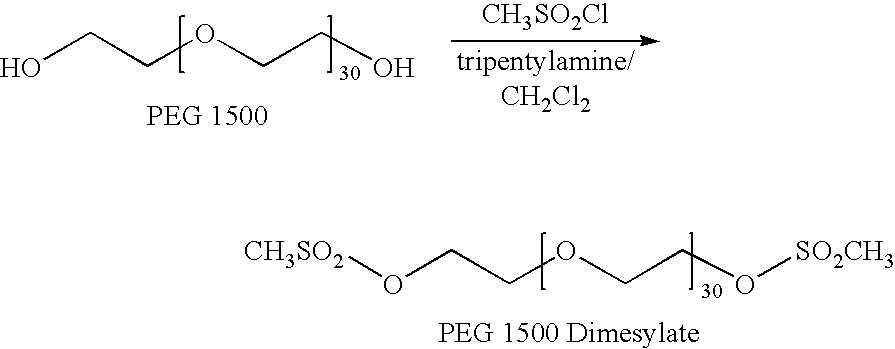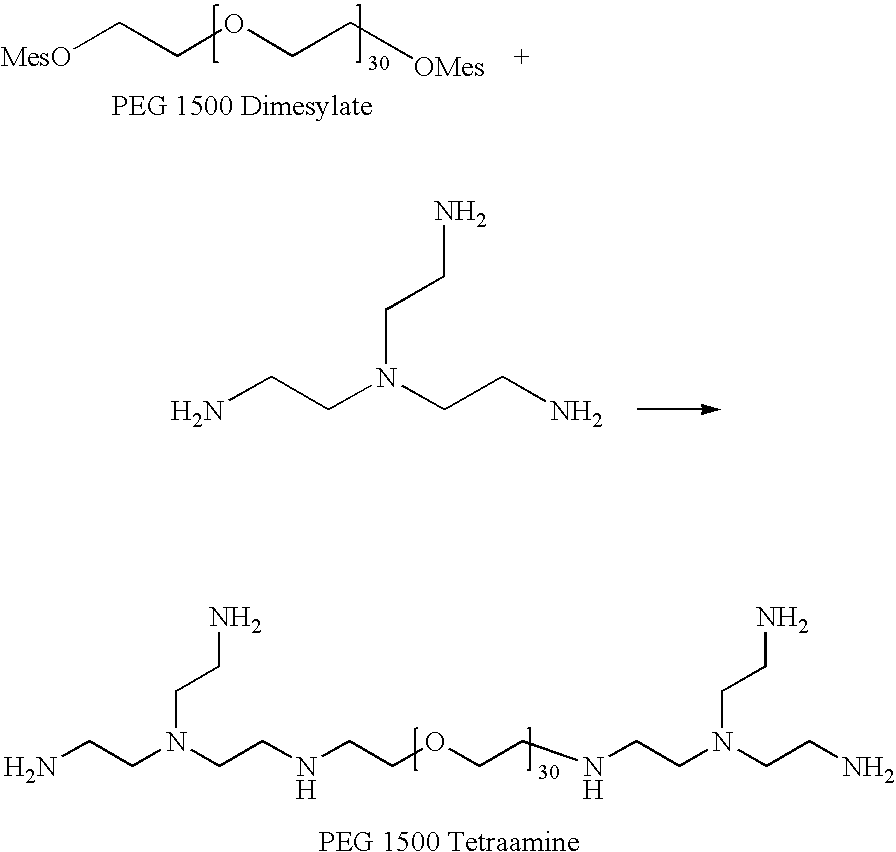Branched end reactants and polymeric hydrogel tissue adhesives therefrom
- Summary
- Abstract
- Description
- Claims
- Application Information
AI Technical Summary
Benefits of technology
Problems solved by technology
Method used
Image
Examples
example 1
Synthesis of Polyethylene Glycol 1500 Branched-End Tetraamine
[0260]The purpose of this Example was to prepare polyethylene glycol 1500 branched-end tetraamine using a two step process. In the first step, PEG 1500 was reacted with methanesulfonyl chloride in dichloromethane in the presence of tripentylamine to produce PEG 1500 dimesylate. Then in the second step, the PEG 1500 dimesylate was reacted with tris(2-aminoethyl)amine in water to yield the polyethylene glycol 1500 branched-end tetraamine.
Preparation of PEG 1500 Dimesylate:
[0261]
[0262]A solution of 15.0 g (22 mmol OH) of polyethylene glycol 1500 (MW=1500; Aldrich #202436) and 10.5 g (13.5 mL; 46 mmol) tripentylamine in 100 mL of dichloromethane was stirred under nitrogen as 6.0 g (4.0 mL; 52 mmol) of methanesulfonyl chloride was added. The solution became warm. The dark red solution was allowed to stand at room temperature for 68 h. Then, the reaction mixture was evaporated to about half its volume using a rotary evaporator a...
examples 2-4
Comparison of Properties of Dextran Aldehyde / PEG Amine Hydrogels:
[0269]The purpose of these Examples was to compare the mechanical properties of a dextran aldehyde hydrogel based on a branched-end PEG amine with those of hydrogels based on monoamine-ended PEGs. The properties of a dextran aldehyde hydrogel made with PEG 1500 branched-end amine were compared with dextran aldehyde hydrogels made from two monoamine-ended PEGs: linear PEG 1500 diamine and 4-arm star PEG 2000 tetraamine. The first comparison is between two linear PEGs of the same molecular weight, one of which has single amine ends and the other of which has branched diamine ends. The second comparison is between a 4-arm star PEG with a single amine on each end with a linear PEG of approximately the same molecular weight having two amines on each end, and thus having the same total number of amines as the star PEG but having them arrayed differently
Synthesis of Linear PEG 1500 Diamine:
[0270]
[0271]A solution of 10.0 g (14...
example 5
Synthesis of 8-Arm Polyethylene Glycol 40000 Hexadecaamine
[0287]The purpose of this Example was to prepare 8-arm polyethylene glycol 40000 hexadecaamine. The hexadecaamine was prepared using a two step procedure in which 8-arm PEG 40K was reacted with thionyl chloride to produce 8-arm PEG 40K chloride, which was subsequently reacted with tris(2-aminoethyl)amine to give the 8-arm PEG 40K hexadecaamine.
Preparation of 8-Arm PEG 40K Chloride:
[0288]
[0289]A solution of 100 g (20 mmol OH) of 8-arm PEG 40K (Mn=40,000; NOF SunBright HGEO-40000) in 200 mL of toluene was heated to 70° C. and stirred under nitrogen as 6 mL of thionyl chloride (10 g; 80 mmol) was quickly added. The mixture was stirred at 60° C. under nitrogen for 20 h. After 20 h the solution was bubbled with nitrogen for 1 h while still warm to remove thionyl chloride and then 2 mL (50 mmol) of methanol was added to scavenge remaining thionyl chloride. The resulting solution was added with stirring to 300 mL of hexane to initia...
PUM
| Property | Measurement | Unit |
|---|---|---|
| Fraction | aaaaa | aaaaa |
| Percent by mass | aaaaa | aaaaa |
| Percent by mass | aaaaa | aaaaa |
Abstract
Description
Claims
Application Information
 Login to View More
Login to View More - R&D
- Intellectual Property
- Life Sciences
- Materials
- Tech Scout
- Unparalleled Data Quality
- Higher Quality Content
- 60% Fewer Hallucinations
Browse by: Latest US Patents, China's latest patents, Technical Efficacy Thesaurus, Application Domain, Technology Topic, Popular Technical Reports.
© 2025 PatSnap. All rights reserved.Legal|Privacy policy|Modern Slavery Act Transparency Statement|Sitemap|About US| Contact US: help@patsnap.com



